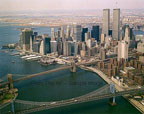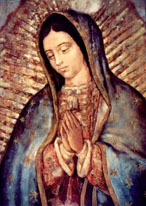
Analysis and Interpretation
 Juan had a
‘bridge’ that brought him from Michoacan, Mexico to the United States.
That ‘bridge’ was his uncles. His story coincides with an article by
Saskia Sassen, entitled “Why Migration,” (Report on the Americas.
25(1) 1992:14-19)in which Sassen discusses the
reasons behind people migrating to certain countries. One reason she
describes are ‘bridges.’ Usually these bridges are initially formed
through economic or wartime contact, which brings the first wave of
immigrants to a new country. Juan is part of a subsequent bridge, which
is that of familial ties to the country he migrated to.
Juan had a
‘bridge’ that brought him from Michoacan, Mexico to the United States.
That ‘bridge’ was his uncles. His story coincides with an article by
Saskia Sassen, entitled “Why Migration,” (Report on the Americas.
25(1) 1992:14-19)in which Sassen discusses the
reasons behind people migrating to certain countries. One reason she
describes are ‘bridges.’ Usually these bridges are initially formed
through economic or wartime contact, which brings the first wave of
immigrants to a new country. Juan is part of a subsequent bridge, which
is that of familial ties to the country he migrated to.
In a journal
article entitled “The Culture of Mexican Migration: A Theoretical and Empirical Analysis” by William Kandel and Douglas S. Massey (Social
Forces 80(3) 2002:981-1004), I found
another correlation between Juan’s migration story and familial ties.
The authors discuss the idea that the likelihood of young people
expecting to migrate to the U.S. is proportional to the number of people
in their villages and families that already do. This is because they
see other members of their community leave and come back with stories of
a good life and opportunity. This is what seemed to drive Juan to come
here and see for himself.
Empirical Analysis” by William Kandel and Douglas S. Massey (Social
Forces 80(3) 2002:981-1004), I found
another correlation between Juan’s migration story and familial ties.
The authors discuss the idea that the likelihood of young people
expecting to migrate to the U.S. is proportional to the number of people
in their villages and families that already do. This is because they
see other members of their community leave and come back with stories of
a good life and opportunity. This is what seemed to drive Juan to come
here and see for himself.
Juan’s coming to live with his uncles is an example of what Stephen Castles and Mark J. Miller describe as causing ‘ethnic clustering’ in their book “New Ethnic Minorities and Societies," in The Age of Migration: International Population Movements in the Modern World (Macmillan Press, 1998, 2nd edition p 212-252). [In the chapter of this book that we read, entitled “New Ethnic Minorities and Society,” the main discussion pertained to three categories, or models, by which countries receiving immigrants define immigration into their societies. The United States is described as having a ‘multicultural model’ of immigration, in which ethnicities are accepted but not recognized fully by the government and legislature.] In the beginning of the chapter, they discuss how the second generation of immigrants to a country are usually aided by family and friends that have already established themselves in a community. The second generation that comes to the country often lives with the first or in their neighborhood. This makes for communities of immigrants from the same place. Juan’s uncles paid for and assisted him in migrating to the U.S. Juan also said that everyone he lived with and interacted with in his community were Spanish-speaking.
Juan’s story
of learning English goes against a statement made by Yeh Ling Ling in an
article by Charles S. Clark entitled “The New Immigrants,” (Congressional
Quarterly Researcher Jan. 24, 1997: 49-72). The argument
by Ling Ling is that “…many immigrants are surrounded only by other
immigrants while they receive bilingual education and multiculturalism”
(Clark, pg 53), and he attributes this to being why new immigrants don’t
‘assimilate’ into American society. Juan came here when he was 14. He
went to a school that had all of the features described by Ling Ling,
yet he still learned English (very well), and was now working at least
one job in a place that was a mix of ethnicities, not just Hispanic.
multiculturalism”
(Clark, pg 53), and he attributes this to being why new immigrants don’t
‘assimilate’ into American society. Juan came here when he was 14. He
went to a school that had all of the features described by Ling Ling,
yet he still learned English (very well), and was now working at least
one job in a place that was a mix of ethnicities, not just Hispanic.
Clark also discusses the fact that immigrants adjust to a new culture after a while. Juan did this as well. He said that it took him a few years to learn English, but once he did he was interacting with people outside of his own culture. The main exploration in Clark’s article was how heavily immigration was impacting modern American economy, culture and society. Clark says that while immigration does change the landscape of the United States, it would take a lot more people to change it drastically. He concludes that there has been no proof to show that immigration negatively affects our economy or culture.
In the book
“Crossing the Boulevard: Strangers, Neighbors, Aliens in a New
 America”
by Warren Lehrer and Judith Sloan (W.W. Norton & Company, New York,
2003), a book of narratives by immigrants in
Queens, New York (our project is based on this book), there are stories
in which the immigrants’ practices are misunderstood. For example, Ali
from Egypt gets strange looks when smoking from his tobacco pipe, like
he’s doing drugs. Juan has encountered similar misunderstandings
pertaining to his religious beliefs. He is Catholic, and as he says in
the narrative, there have been people who teased him about the Virgin
Mary. Both of these examples show how people misinterpret and/or are
insensitive to migrants’ daily lives and beliefs.
America”
by Warren Lehrer and Judith Sloan (W.W. Norton & Company, New York,
2003), a book of narratives by immigrants in
Queens, New York (our project is based on this book), there are stories
in which the immigrants’ practices are misunderstood. For example, Ali
from Egypt gets strange looks when smoking from his tobacco pipe, like
he’s doing drugs. Juan has encountered similar misunderstandings
pertaining to his religious beliefs. He is Catholic, and as he says in
the narrative, there have been people who teased him about the Virgin
Mary. Both of these examples show how people misinterpret and/or are
insensitive to migrants’ daily lives and beliefs.
Back to My Crossing The Valley Main